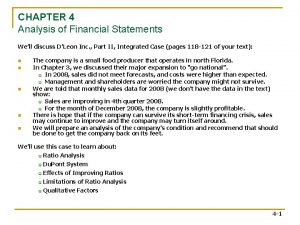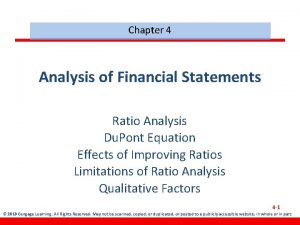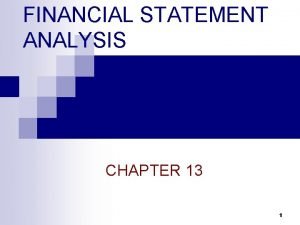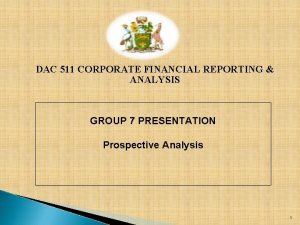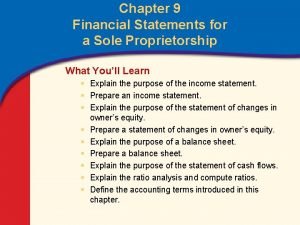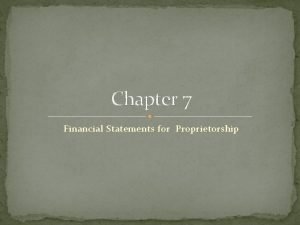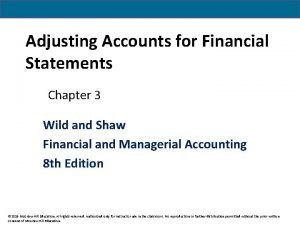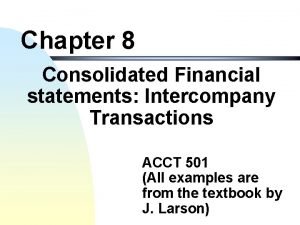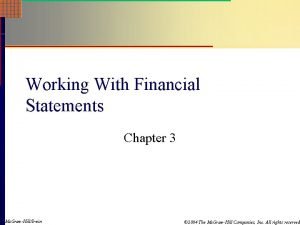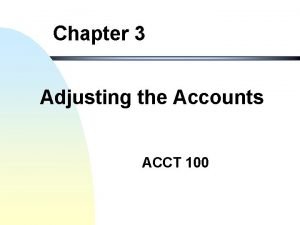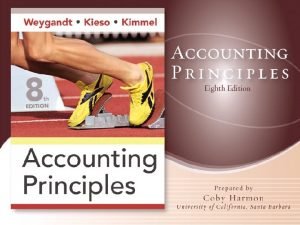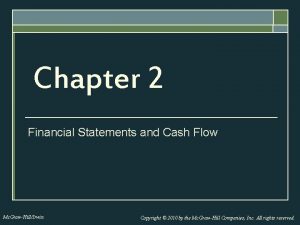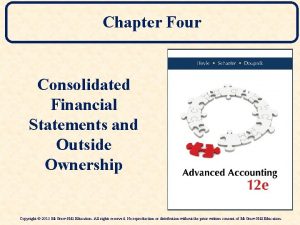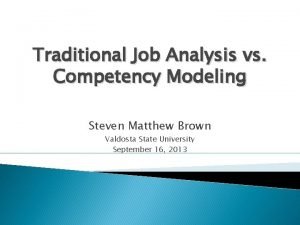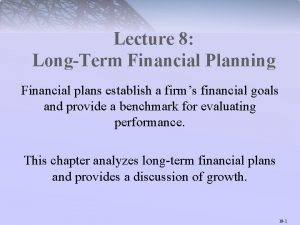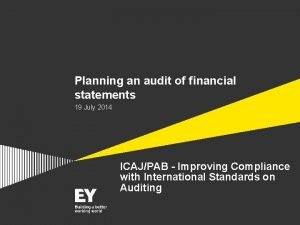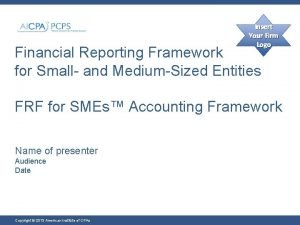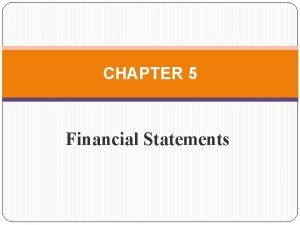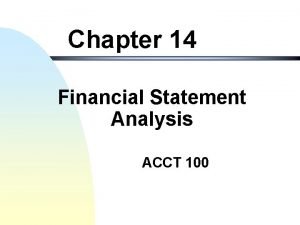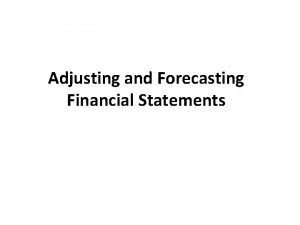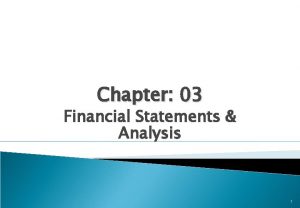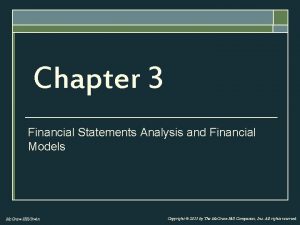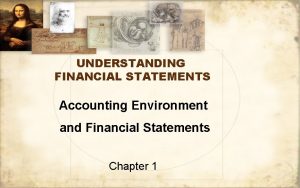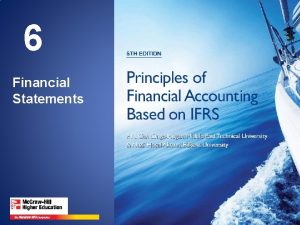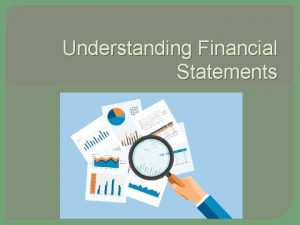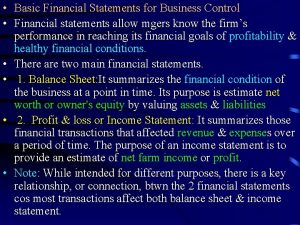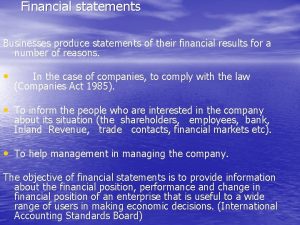Chapter 3 Financial Statements Analysis and Financial Models




























- Slides: 28

Chapter 3 Financial Statements Analysis and Financial Models

Key Concepts and Skills Know how to standardize financial statements for comparison purposes � Know how to compute and interpret important financial ratios � Be able to develop a financial plan using the percentage of sales approach � Understand how capital structure and dividend policies affect a firm’s ability to grow � Copyright © 2016 Mc. Graw-Hill Education. All rights reserved. No reproduction or distribution without the prior written consent of Mc. Graw-Hill Education. 3 -1

Chapter Outline Financial Statements Analysis Ratio Analysis Financial Models External Financing and Growth Some Caveats Regarding Financial Planning Models Copyright © 2016 Mc. Graw-Hill Education. All rights reserved. No reproduction or distribution without the prior written consent of Mc. Graw-Hill Education. 3 -2

3. 1 Financial Statements Analysis Common-Size Balance Sheets ◦ Compute all accounts as a percent of total assets � Common-Size Income Statements ◦ Compute all line items as a percent of sales � Standardized statements make it easier to compare financial information, particularly as the company grows. � They are also useful for comparing companies of different sizes, particularly within the same industry. � Copyright © 2016 Mc. Graw-Hill Education. All rights reserved. No reproduction or distribution without the prior written consent of Mc. Graw-Hill Education. 3 -3

Common size Income statement measurements commonly used by analyst and investors � Net Income (the bottom line) Revenues minus expenses. � EPS – Earnings per share (net income/number of common stock shares outstanding) � EBIT – Earnings before interest and taxes (income from operations). It is income before unusual items, discontinued operations, or extraordinary items. � EBITDA – Earnings before interest, taxes, depreciation and amortization. It is a better measure of before tax cash flow. 3 -4

Ratio Analysis � � � Financial Ratios also allow for better comparison through time or between companies. These ratios are ways of comparing and investigation the relationships between different pieces of information As we look at each ratio, ask yourself: ◦ ◦ ◦ How is the ratio computed? What is the ratio trying to measure and why? What is the unit of measurement? What does the value indicate? How can we improve the company’s ratio? Copyright © 2016 Mc. Graw-Hill Education. All rights reserved. No reproduction or distribution without the prior written consent of Mc. Graw-Hill Education. 3 -5

Categories of Financial Ratios Short-term solvency or liquidity ratios � Long-term solvency or financial leverage ratios � Asset management or turnover ratios � Profitability ratios � Market value ratios � Copyright © 2016 Mc. Graw-Hill Education. All rights reserved. No reproduction or distribution without the prior written consent of Mc. Graw-Hill Education. 3 -6

Computing Liquidity Ratios � Current Ratio = CA / CL (best known and widely used for short term liquidity) (what if it is less than 1) (How strong is the ratio) ◦ 708 / 540 = 1. 31 times � Quick Ratio = (CA – Inventory) / CL (also called acid – test) uses the most liquid of assets ◦ (708 - 422) / 540 =. 53 times � Cash Ratio = Cash / CL ◦ 98 / 540 =. 18 times Copyright © 2016 Mc. Graw-Hill Education. All rights reserved. No reproduction or distribution without the prior written consent of Mc. Graw-Hill Education. 3 -7

Computing Financial Leverage Ratios – Long term solvency measurements � � Can the company meets its long run ability to meet its obligation Total Debt Ratio = (TA – TE) / TA (TA =Total Assets, TE = Total Equity) ◦ (3588 - 2591) / 3588 = 28% � Debt/Equity = TD / TE (TD = Total Debt) ◦ (3588 – 2591) / 2591 = 38. 5% � Equity Multiplier = TA / TE = 1 + D/E ◦ 1 +. 385 = 1. 385 Copyright © 2016 Mc. Graw-Hill Education. All rights reserved. No reproduction or distribution without the prior written consent of Mc. Graw-Hill Education. 3 -8

Computing Coverage Ratios for a measurement of long term solvency � Times Interest Earned = EBIT / Interest ◦ 691 / 141 = 4. 9 times (Interest coverage ratio) � Cash Coverage = (EBIT + Depreciation + Amortization) / Interest ◦ (691 + 276) / 141 = 6. 9 times ◦ This is a basic measure of the firms ability to generate cash from operations and is frequently used as a measure of cash flow to meet financial obligations. Copyright © 2016 Mc. Graw-Hill Education. All rights reserved. No reproduction or distribution without the prior written consent of Mc. Graw-Hill Education. 3 -9

Computing Inventory Ratios � These are asset management ratios or utilization ratios to check and see how efficent the firms uses it assets � Inventory Turnover = Cost of Goods Sold / Inventory ◦ 1344 / 422 = 3. 2 times ( we turned over the entire inventory 3. 2 times in a year) � Days’ Sales in Inventory = 365 / Inventory Turnover ◦ 365 / 3. 2 = 114 days ( we have 114 days of inventory on hand to sell). Copyright © 2016 Mc. Graw-Hill Education. All rights reserved. No reproduction or distribution without the prior written consent of Mc. Graw-Hill Education. 3 -10

Computing Receivables Ratios � How fast do we collect our Receivables � Receivables Turnover = Sales / Accounts Receivable ◦ 2311 / 188 = 12. 3 times ( we collected our outstanding credit and lent the money our again 12. 3 times during the year) � Days’ Sales in Receivables = 365 / Receivables Turnover ◦ 365 / 12. 3 = 30 days (On average we collect our credit sales In 30 days, called the average collection period) Copyright © 2016 Mc. Graw-Hill Education. All rights reserved. No reproduction or distribution without the prior written consent of Mc. Graw-Hill Education. 3 -11

Computing Total Asset Turnover � Total Asset Turnover = Sales / Total Assets ◦ 2311 / 3588 =. 64 times (For every dollar in assets, the firm generated $. 64 in sales) ◦ It is not unusual for TAT < 1, especially if a firm has a large amount of fixed assets. Copyright © 2016 Mc. Graw-Hill Education. All rights reserved. No reproduction or distribution without the prior written consent of Mc. Graw-Hill Education. 3 -12

Computing Profitability Measures They are intended to measure how efficiently the firm uses its assets and how efficiently the firm manages its operations. � Profit Margin = Net Income / Sales � ◦ 363 / 2311 = 15. 7% (for every $1 in sales the firm gets $. 157 in net income � Return on Assets (ROA) = Net Income / Total Assets ◦ 363 / 3588 = 10. 1% (profit per $1 of assets) � Return on Equity (ROE) = Net Income / Total Equity ◦ 363 / 2591 = 14. 0% (true bottom line of performance) � EBITDA Margin = EBITDA / Sales ◦ 967 / 2311 = 41. 8% (operating cash flow per $1 of sales Copyright © 2016 Mc. Graw-Hill Education. All rights reserved. No reproduction or distribution without the prior written consent of Mc. Graw-Hill Education. 3 -13

� � Computing Market Value Measures based on information not contained in financial statements Market Capitalization = $88 per share x 33 million shares = $2, 904 million (market price times shares outstanding) PE Ratio = Price per share / Earnings per share ◦ 88 / 11 = 8 times (investors willing to pay 8 time earnings for stock) � Market-to-book ratio = market value per share / book value per share ◦ 88 / (2591 / 33) = 1. 12 times (Value has been created) � Enterprise Value (EV) = Market capitalization + Market value of interest bearing debt – cash ◦ 2904 + (196 + 457) – 98 = $3, 459( this is a better estimate on how much it would take to buy all of the outstanding stock and pay off the debt) � EV Multiple = EV / EBITDA ◦ 3459 / 967 = 3. 6 times (how many time is EV of total cash flow) Copyright © 2016 Mc. Graw-Hill Education. All rights reserved. No reproduction or distribution without the prior written consent of Mc. Graw-Hill Education. 3 -14

Using Financial Statements � � Ratios are not very helpful by themselves: they need to be compared to something Time-Trend Analysis ◦ Used to see how the firm’s performance is changing through time � Peer Group Analysis ◦ Compare to similar companies or within industries ◦ SIC and NAICS codes ◦ A good summary of the ratios are on page 57. Copyright © 2016 Mc. Graw-Hill Education. All rights reserved. No reproduction or distribution without the prior written consent of Mc. Graw-Hill Education. 3 -15

Potential Problems � � � There is no underlying theory, so there is no way to know which ratios are most relevant. Benchmarking is difficult for diversified firms. Globalization and international competition makes comparison more difficult because of differences in accounting regulations. Firms use varying accounting procedures. Firms have different fiscal years. Extraordinary, or one-time, events can affect some of the ratios. Be careful and use caution in ratio analysis and make sure you understand the numbers being used. Copyright © 2016 Mc. Graw-Hill Education. All rights reserved. No reproduction or distribution without the prior written consent of Mc. Graw-Hill Education. 3 -16

Financial Models Financial planner models use Pro Forma statements – “as a matter of form” or “what if statements” � Investment in new assets – determined by capital budgeting decisions � Degree of financial leverage – determined by capital structure decisions � Cash paid to shareholders – determined by dividend policy decisions � Liquidity requirements – determined by net working capital decisions � Copyright © 2016 Mc. Graw-Hill Education. All rights reserved. No reproduction or distribution without the prior written consent of Mc. Graw-Hill Education. 3 -17

Financial Planning Ingredients � � � Sales Forecast – many cash flows depend directly on the level of sales (often estimate sales growth rate) Pro Forma Statements – setting up the plan as projected (pro forma) financial statements allows for consistency and ease of interpretation Asset Requirements – the additional assets that will be required to meet sales projections Financial Requirements – the amount of financing needed to pay for the required assets Plug Variable – determined by management decisions about what type of financing will be used (makes the balance sheet balance) Economic Assumptions – explicit assumptions about the coming economic environment Copyright © 2016 Mc. Graw-Hill Education. All rights reserved. No reproduction or distribution without the prior written consent of Mc. Graw-Hill Education. 3 -18

Percent of Sales Approach Some items vary directly with sales, others do not. � Income Statement � ◦ Costs may vary directly with sales - if this is the case, then the profit margin is constant ◦ Depreciation and interest expense may not vary directly with sales – if this is the case, then the profit margin is not constant ◦ Dividends are a management decision and generally do not vary directly with sales – this affects additions to retained earnings ◦ The Estimate of Sales is very important to the use of a sales model. Copyright © 2016 Mc. Graw-Hill Education. All rights reserved. No reproduction or distribution without the prior written consent of Mc. Graw-Hill Education. 3 -19

Percent of Sales Approach � Balance Sheet ◦ Initially assume all assets, including fixed, vary directly with sales. ◦ Accounts payable also normally vary directly with sales. ◦ Notes payable, long-term debt, and equity generally do not vary with sales because they depend on management decisions about capital structure. ◦ The change in the retained earnings portion of equity will come from the dividend decision. � External Financing Needed (EFN) ◦ The difference between the forecasted increase in assets and the forecasted increase in liabilities and equity. Copyright © 2016 Mc. Graw-Hill Education. All rights reserved. No reproduction or distribution without the prior written consent of Mc. Graw-Hill Education. 3 -20

External Financing and Growth At low growth levels, internal financing (retained earnings) may exceed the required investment in assets. � As the growth rate increases, the internal financing will not be enough, and the firm will have to go to the capital markets for financing. � Examining the relationship between growth and external financing required is a useful tool in financial planning. � The higher the rate of growth is sales or assets, the greater will be the need for external financing. It takes cash to grow. � Copyright © 2016 Mc. Graw-Hill Education. All rights reserved. No reproduction or distribution without the prior written consent of Mc. Graw-Hill Education. 3 -21

The Internal Growth Rate � � The internal growth rate tells us how much the firm can grow assets using retained earnings as the only source of financing. Using the information from the Hoffman Co. ◦ ROA = 66 / 500 =. 132 ◦ b = 44/ 66 =. 667 (b is plowback ratio) Copyright © 2016 Mc. Graw-Hill Education. All rights reserved. No reproduction or distribution without the prior written consent of Mc. Graw-Hill Education. 3 -22

The Sustainable Growth Rate � � The sustainable growth rate tells us how much the firm can grow by using internally generated funds and issuing debt to maintain a constant debt ratio. Using the Hoffman Co. ◦ ROE = 66 / 250 =. 264 ◦ b =. 667 Copyright © 2016 Mc. Graw-Hill Education. All rights reserved. No reproduction or distribution without the prior written consent of Mc. Graw-Hill Education. 3 -23

Determinants of Growth � � � Profit margin – operating efficiency Total asset turnover – asset use efficiency Financial leverage – choice of optimal debt ratio Dividend policy – choice of how much to pay to shareholders versus reinvesting in the firm If a firm does not wish to sell new equity and its profit margin, dividend policy, financial policy and the total asset turnover are all fixed, then there is only one possible growth rate. The sustainable growth rate. Copyright © 2016 Mc. Graw-Hill Education. All rights reserved. No reproduction or distribution without the prior written consent of Mc. Graw-Hill Education. 3 -24

Some Caveats � � � Financial planning models do not indicate which financial polices are the best. Models are simplifications of reality, and the world can change in unexpected ways. Without some sort of plan, the firm may find itself adrift in a sea of change without a rudder for guidance. The models rely upon historical accounting relationships Financial planning is an iterative process that are created, examined, modified over and over. The process is never over. Copyright © 2016 Mc. Graw-Hill Education. All rights reserved. No reproduction or distribution without the prior written consent of Mc. Graw-Hill Education. 3 -25

Quick Quiz � What are the major categories of financial ratios? � How do you compute the ratios within each category? � What are some of the problems associated with financial statement analysis? Copyright © 2016 Mc. Graw-Hill Education. All rights reserved. No reproduction or distribution without the prior written consent of Mc. Graw-Hill Education. 3 -26

Quick Quiz What is the purpose of financial planning? � What are the major decision areas involved in developing a plan? � What is the percentage of sales approach? � What is the internal growth rate? � What is the sustainable growth rate? � What are the major determinants of growth? � Copyright © 2016 Mc. Graw-Hill Education. All rights reserved. No reproduction or distribution without the prior written consent of Mc. Graw-Hill Education. 3 -27
 Chapter 03 financial analysis
Chapter 03 financial analysis How to improve current ratio
How to improve current ratio Chapter 4 analysis of financial statements
Chapter 4 analysis of financial statements Chapter 4 analysis of financial statements
Chapter 4 analysis of financial statements Banks income statement analysis
Banks income statement analysis Chapter 2 financial statements taxes and cash flow
Chapter 2 financial statements taxes and cash flow Modals differences
Modals differences Chapter 13 financial statement analysis
Chapter 13 financial statement analysis Prospective analysis financial statements
Prospective analysis financial statements Chapter 3 adjusting accounts for financial statements
Chapter 3 adjusting accounts for financial statements Sole proprietorship income statement
Sole proprietorship income statement Sole proprietorship financial statements
Sole proprietorship financial statements Adjusting accounts for financial statements chapter 3
Adjusting accounts for financial statements chapter 3 Intercompany bond transactions
Intercompany bond transactions Working with financial statements chapter 3
Working with financial statements chapter 3 Adjusting the accounts chapter 3
Adjusting the accounts chapter 3 Chapter 3 adjusting accounts for financial statements
Chapter 3 adjusting accounts for financial statements 2-2 journal: financial statements and cash flow management
2-2 journal: financial statements and cash flow management Unit 13 accounting and financial statements
Unit 13 accounting and financial statements Consolidated financial statements and outside ownership
Consolidated financial statements and outside ownership Traditional job analysis
Traditional job analysis Financial planning models
Financial planning models Financial report purpose
Financial report purpose Planning an audit of financial statements
Planning an audit of financial statements Sample notes to financial statements for small entities
Sample notes to financial statements for small entities Translate financial statements
Translate financial statements Corporate financial reporting objectives
Corporate financial reporting objectives Acct 100
Acct 100 Parsimonious method of forecasting
Parsimonious method of forecasting


